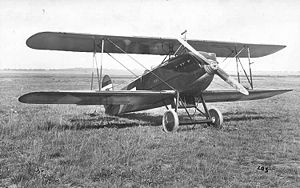Avia BH-21 Video -

|
|
Avia BH-21
BH-21

Role: Fighter
Manufacturer: Avia
Designed by: Pavel Beneš and Miroslav Hajn
First flight: January 1925
Number built: 140 (incl BH-21J and BH-21R) + 44 licence-built in Belgium by SABCA
The Avia BH-21, first built in 1925, was a robust biplane that served an important role in securing Czechoslovak national security during the period between World War I and World War II. As well as being a competent fighter, it was also an accomplished racer, winning several air races of its time.
History
A conventional biplane, the predecessor of the BH-21, the Avia BH-17, was designed by Pavel Beneš and Miroslav Hajn in 1922 as a response to a Czechoslovak Defense Department requirement for a new fighter aircraft. The BH-17 was actually only part of five Avia designs submitted to the Defense Department along with competing designs from the Letov Kbely and Aero companies. After extensive review, the BH-17, one of Avia's three biplane designs, was chosen and limited production initiated for evaluative purposes. Testing revealed some deficiencies in the BH-17 and a subsequent redesign in 1924 morphed the BH-17 into its final form as the BH-21 which included straightened interplane bracing and allowed for better field of view for the pilot. A special training version, designated the BH-22, was also created. Both versions utilized 224kW (300hp) Hispano-Suiza 8fb engines built under license by Å koda. The BH-21 was put into production in 1925 and had a one-year production run which yielded 182 aircraft with 137 being produced by Avia for the Czechoslovak Air Force, one more was built by Avia for SABCA and another 44 were produced under license by the Belgian company, Société Anonyme Belge de Constructions Aéronautiques "SABCA" for the Belgian Air Force. There were also two experimental variants: BH-21J with Jupiter engine (predecessor of BH-33) and a race plane BH-21R with boosted HS-8Fb engine (298kW/400hp). While in service, the BH-21 saw no combat as it was retired before the outbreak of World War II. In spite of this, it served as an important stepping stone to the more advanced BH-33 and BH-53 types. The BH-21's most lasting achievement came when a racing version, the BH-21R, won several national air-race competitions in 1925 sporting an upgraded HS 8Fb engine producing over 298kW (400hp).
Variants
BH-21: Single-seat fighter aircraft.
BH-21J: One BH-21 fitted with a Bristol Jupiter radial piston engine. Led to the development of the Avia BH-33.
Bh-21R: Single-seat clipped-wing racing aircraft.
Operators
Belgium
Czechoslovakia
Specifications (BH-21)
General characteristics
Crew: one, pilot
Length: 6.87 m (22 ft 6½ in)
Wingspan: 8.90 m (29 ft 2⅜ in)
Height: 2.74 m (8 ft 11â…ž in)
Wing area: 21.96 m² (236â…œ ft²)
Empty weight: 720 kg (1,587 lb)
Max takeoff weight: 1,085 kg (2,392 lb)
Powerplant: 1x— Hispano-Suiza 8Fb V8 engine, 227 kW @ 1,850 rpm (305 hp)
Performance
Maximum speed: 245 km/h at 3,000 m (9,843 ft) (132 kn, 152 mph)
Service ceiling: 5,500 m (18,045 ft)
Rate of climb: 16 minutes to 5,000 m (16,404 ft)
Endurance: 2 h
Armament
2 x— 7.7 mm (.303 in) Vickers machine guns in the upper front fuselage
Related development BH-17 - BH-22 - BH-23 - BH-33
Living Warbirds: The best warbirds DVD series.
Source: WikiPedia